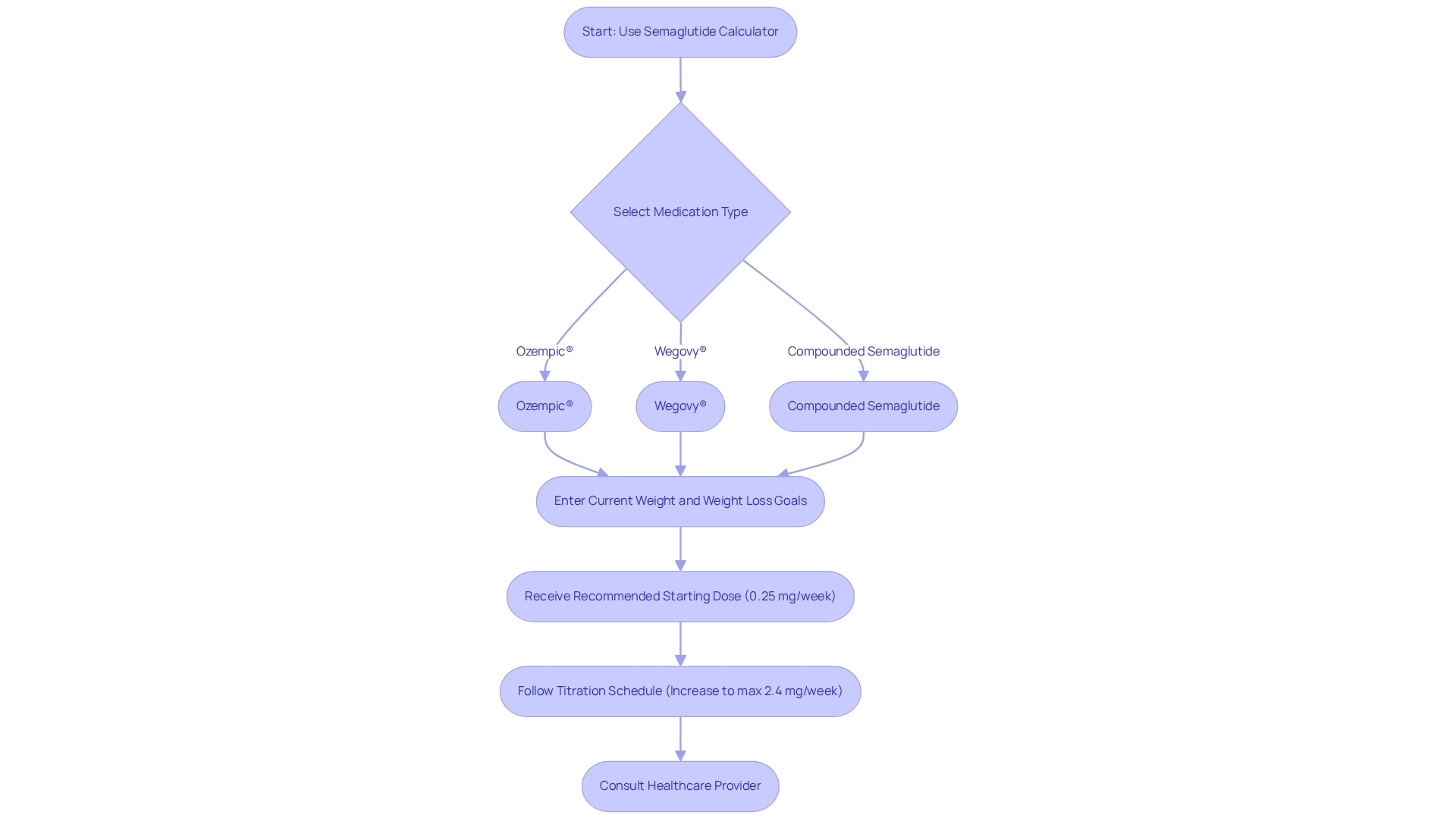Overview
This article is dedicated to helping you navigate your weight loss journey with the semaglutide dosage calculator. We understand that this process can feel overwhelming, but personalized dosage based on your unique health needs and goals is essential for success. By following a simple, step-by-step process to determine the correct dosage, you can take control of your appetite and make meaningful progress.
We want to emphasize the importance of consulting with healthcare providers to ensure that your treatment is both safe and effective. Remember, you are not alone in this journey; together, we can achieve your goals. With the right support and guidance, you can find a path that works for you.
Introduction
In the journey toward effective weight loss solutions, we understand how overwhelming it can feel. Semaglutide has emerged as a groundbreaking option, initially designed for managing type 2 diabetes. This glucagon-like peptide-1 (GLP-1) receptor agonist not only curbs appetite but also promotes significant weight loss, with clinical studies showcasing impressive results. As we explore the multifaceted benefits of semaglutide, it becomes essential to navigate its usage effectively.
It’s not just about grasping its weight loss potential; it’s also about mastering the dosage calculator to tailor the treatment to your personal health goals. With expert insights and step-by-step guidance, this article delves into the essentials of semaglutide. Together, we can harness its full potential while ensuring safety and efficacy in your weight management endeavors. Remember, we’re here for you every step of the way.
Understand Semaglutide and Its Role in Weight Loss
Semaglutide is a glucagon-like peptide-1 (GLP-1) receptor agonist that can significantly assist in reducing body mass. Initially developed for the treatment of type 2 diabetes, it mimics the effects of the GLP-1 hormone, which plays a crucial role in regulating appetite and food intake. By activating GLP-1 receptors in the brain, this medication helps diminish feelings of hunger, leading to reduced calorie intake. Many individuals using this medication have achieved remarkable reductions in body mass, with some shedding up to 20% of their body composition over time.
The STEP 5 trial, an essential phase 3 study, reinforced the effectiveness and safety of this treatment for body management, showcasing its long-term benefits. In this rigorous trial, participants experienced significant reductions in mass, confirming its viability as a treatment option for obesity. Importantly, the incidence of serious adverse events was similar to that of a placebo, with rates of 50.48, 49.66, 52.73, and 60.85 per 100 years of observation, highlighting its safety profile. Notably, no differences were observed between groups regarding benign and malignant tumors, providing a balanced perspective on the treatment’s safety. Additionally, recent findings indicated that 10.5% of participants in the treatment group reported COVID-19 infections, compared to 5.3% in the placebo group, with few cases categorized as serious. This emphasizes the importance of ongoing observation in clinical settings, ensuring that patients receive the highest quality care throughout their treatment journey.
Beyond its fat loss benefits, semaglutide also lowers blood sugar levels in individuals with type 2 diabetes, enhances insulin sensitivity, and reduces the risk of heart disease and other diabetic complications. It improves long-term A1C levels and can be taken with or without insulin. However, it is essential to consider potential side effects such as stomach discomfort, nausea, and rare but serious lactic acidosis. Sean Wharton, a respected specialist in body management, contributed to the acquisition, analysis, and interpretation of data regarding the drug’s effectiveness. He emphasizes the transformative potential of GLP-1 receptor agonists in managing body mass. As more individuals seek effective approaches to obesity, understanding how this medication works is vital for maximizing its benefits and achieving sustainable weight loss together.
Utilize the Semaglutide Dosage Calculator Effectively
If you’re feeling overwhelmed by your weight loss journey, the semaglutide calculator can be a helpful tool. Start by selecting the right medication type, whether it’s Ozempic®, Wegovy®, or compounded semaglutide. By entering your current weight and your weight loss goals, you’ll receive a recommended starting dose, typically beginning at 0.25 mg per week.
It’s important to follow the recommended titration schedule, which usually involves gradually increasing your dose to a maximum of 2.4 mg weekly, based on how your body responds. Remember, consulting with your healthcare provider is key to ensuring that the dosage aligns with your unique health needs.
Wegovy® works by regulating your appetite and food intake, which can lead to significant weight loss and improved blood sugar control. Did you know that in 2022, over 13 million prescriptions for semaglutide were written? This statistic highlights its effectiveness and the trust patients place in it.
Expert suggestions emphasize the importance of tailoring your medication to enhance your treatment results. Together, we can achieve your goals, and with the right support and guidance, you can navigate this journey successfully.
Follow Step-by-Step Instructions for Accurate Dosage Calculation
- Determine Your Starting Dose: We understand that starting a new medication can be daunting. Begin with the recommended starting dose of 0.25 mg per week. This allows your body to adjust gently to Mounjaro, which is administered as a once-weekly injection under the skin of your stomach, thigh, or upper arm. Remember to inject it on the same day each week to establish a routine that works for you.
- Input Your Present Mass: Take a moment to enter your current mass into the semaglutide dosage calculator. This step is crucial as it helps tailor the dosage to your specific needs, ensuring that you are supported throughout your journey.
- Establish Your Reduction Objectives: What are your goals? Specify your target decrease, as this information will guide the semaglutide dosage calculator in suggesting an appropriate dosage that aligns with your aspirations.
- Review the Titration Schedule: After four weeks, if you’re feeling good and tolerating the medication well, consider increasing your dose to 0.5 mg weekly. Continue to follow this titration schedule, increasing the dose every four weeks as needed, up to a maximum of 2.4 mg weekly. Mounjaro is here to support you not only in reducing body mass by suppressing appetite but also in enhancing blood sugar management for those with type 2 diabetes. This makes it a valuable choice for anyone navigating both body composition and diabetes management.
- Monitor Your Progress: Keep track of your progress and any side effects you might experience. Remember, adjustments may be necessary based on your individual response to the medication. Always consult your healthcare provider before making any changes. Together, we can achieve your goals.
Troubleshoot Common Issues with the Dosage Calculator
- Incorrect Dosage Recommendations: If the semaglutide dosage calculator indicates a dosage that appears too high or too low, please take a moment to verify your input values. Accurate entries of your weight and health goals are essential for using a semaglutide dosage calculator to receive precise recommendations tailored to you.
- Calculator Not Functioning: If the calculator becomes unresponsive, don’t worry—try refreshing the page or switching to a different browser. Remember, a stable internet connection is crucial for optimal performance.
- Confusion Over Units: It’s important to clarify unit measurements; for instance, 1 mg of semaglutide typically equals 20 units in a syringe. Always consult the measurement chart for accurate conversions.
- Side Effects Management: Are you experiencing side effects like nausea? Please reach out to your healthcare provider for advice. They may suggest adjustments to your dosage or strategies to help alleviate any discomfort you may feel. Consulting healthcare providers is important; if you have any questions or concerns regarding your dosage or the semaglutide dosage calculator’s recommendations, always consult your healthcare provider. Their personalized guidance is invaluable in ensuring your health and safety.
At Minimal, we’re here for you, offering a range of wellness services, including fitness training and nutrition guidance, to support you on your weight loss journey. Together, we can achieve your goals.
Conclusion
The exploration of semaglutide as a weight loss solution shines a light on its remarkable potential, especially for those grappling with obesity. As a GLP-1 receptor agonist, semaglutide not only helps regulate appetite but also supports significant weight loss, backed by clinical evidence of its effectiveness and safety. The STEP 5 trial showcased its capacity to assist participants in losing considerable weight while maintaining a safety profile comparable to placebo. Additionally, its benefits extend to improving blood sugar levels in type 2 diabetes and reducing the risk of heart disease, reinforcing its role in holistic health management.
Effectively utilizing the semaglutide dosage calculator is essential for achieving the best results. By entering accurate details about current weight and weight loss goals, individuals can receive personalized dosage recommendations that ensure safe and effective treatment. Adhering to the suggested titration schedule and monitoring progress are crucial steps in this journey, allowing for necessary adjustments based on personal responses.
While navigating the dosage calculator may pose challenges, addressing common issues can lead to a smoother experience. It’s vital to engage with healthcare providers for tailored guidance, ensuring that the treatment plan aligns with your specific health needs. As the popularity of semaglutide continues to grow, understanding its functions and proper usage empowers you to unlock its full potential, paving the way for sustainable weight loss and overall well-being. Remember, together, we can achieve your goals and foster a healthier future.
Frequently Asked Questions
What is Semaglutide and how does it work?
Semaglutide is a glucagon-like peptide-1 (GLP-1) receptor agonist that helps reduce body mass. It mimics the GLP-1 hormone, which regulates appetite and food intake, by activating GLP-1 receptors in the brain, thereby reducing feelings of hunger and leading to decreased calorie intake.
What were the results of the STEP 5 trial regarding Semaglutide?
The STEP 5 trial demonstrated the effectiveness and safety of Semaglutide for body management, showing significant reductions in body mass among participants. The incidence of serious adverse events was similar to that of a placebo, confirming its safety profile.
How much body mass can individuals expect to lose while using Semaglutide?
Many individuals using Semaglutide have achieved notable reductions in body mass, with some losing up to 20% of their body composition over time.
What are the safety concerns associated with Semaglutide?
The safety profile of Semaglutide shows that serious adverse events occurred at rates comparable to a placebo, with no significant differences in benign and malignant tumors. However, potential side effects may include stomach discomfort, nausea, and rare cases of serious lactic acidosis.
Does Semaglutide have benefits beyond weight loss?
Yes, Semaglutide also lowers blood sugar levels in individuals with type 2 diabetes, enhances insulin sensitivity, and reduces the risk of heart disease and other diabetic complications. It improves long-term A1C levels and can be taken with or without insulin.
What is the importance of ongoing observation in clinical settings for Semaglutide users?
Ongoing observation is crucial to ensure that patients receive high-quality care throughout their treatment journey, as it helps monitor any potential side effects and the overall effectiveness of the medication.


















